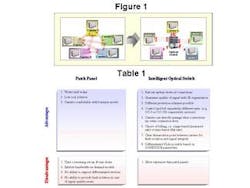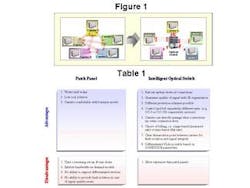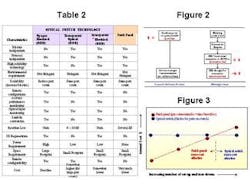New services enabled by intelligent optical switches at colocation facilities
The use of intelligent optical switches reduces complexity and speeds connection times. It also offers opportunities for new offerings.
Hunter Newby
The telX group
Lakshmi Raman and Shantanu Mitra
TeraBurst Networks
The 1996 telecommunications deregulation act spawned many new entrants into the service provider market. In many cases these new, competitive local exchange carriers (CLECs) required new facilities to house their equipment. To address the CLECs' needs for appropriate facilities for their equipment and interconnectivity to other carriers -- including the incumbent LECs -- building owners and managers in large urban areas began offering vacant office space to provide central office (CO) -like facilities that were popularly called "carrier hotels."
The services offered at carrier hotels vary widely. Since many emerging CLECs did not have resources to develop their own CO-like environments, some carrier hotels started offering CO-like "conditioned space" appropriate for the requirements of telecommunications equipment. Additionally, some of these carrier-hotel tenants initially required only a single equipment rack and could not justify leasing significant amounts of space. A business opportunity thus existed within the carrier hotels to aggregate or colocate service providers in a common space and provide interconnection services among them.
Colocation services today
Typical colocation service providers (CSPs) offer connection services between different carriers and provide a certain level of infrastructure to support this. These services include redundant UPS and DC power, HVAC secure cabinets, equipment staging areas, fire suppression systems, 24/7 security, installation and 24/7 technical support, and cross-connection service (copper, coax, singlemode and multimode optical fiber).
Today, optical connections among the different telecommunications service providers are typically made using patch panels. Consider the five carriers shown in Figure 1. For connectivity each has a patch panel next to its equipment cage and manual connections are made between the patch panels. Most CSPs today take between 48 and 72 hours to fulfill an interconnection request from their carrier tenants.
While this manual approach works today, it is time consuming and is often associated with additional costs -- especially if raceway construction and fiber installation are required to various locations within the colocation facilities. Furthermore, before making any connections using the patch-panel approach, it is necessary to assure that losses through the fibers, connectors, and splices do not degrade the signals to unacceptably poor levels. In the event of poor-quality signals, clear demarcation points between carriers are important for fault-isolation purposes. The passive nature of the manual patch panel, however, does not allow for this.
Moreover, it has often been argued that once the interconnections are made, they stay configured for a long time. Thus, the inconvenience and inefficiency of a patch panel are not seen as impediments to the growth of new services. However, if new services are to be offered, more efficient and convenient setup and teardown of interconnections must be available.
Value-added services using intelligent optical switches
The desire to provide customers with more has driven some CSPs to consider:
1. Automating the interconnection service for speed and flexibility, and
2. Offering more value-added services like "managed hub" services.
Figure 1 shows the use of an optical switch to provide connectivity among carriers in an efficient hub/spoke configuration compared to the mesh configuration using patch panels. With an optical switch, setting up and tearing down connections can be easily accomplished between ports on the switch to which the carriers are connected. User-friendly graphical user interfaces (GUIs) and remote accessibility through any web browser are features that make these switches easy to use -- especially since active control of the connectivity can be offered directly to the carriers themselves.
The use of intelligent optical switches can dramatically enhance the nature of the services being offered at the colocation facilities and can be used as an adjunct to the existing patch panel processes to address a different set of needs. A comparison of the functionality of both systems is shown in Table 1.
Optical switch technologies compared
There are three potential technology categories that could be used to provide -- to varying degrees -- the optical switching functionality described earlier. The characteristics of these technologies are compared in Table 2.
From a feature-by-feature comparison, it can be seen from the table that, for every feature except cost, only the transparent OEO switches are either equivalent or better than the patch panels used today. Although optical switch systems will always be more expensive than patch panels, pure capital expenditure comparisons do not necessarily provide the complete setting for determining the applicability of optical switches. An analysis of the usage and billing methodology, i.e., the business model, must also be evaluated in any decision to deploy optical switches.
Business models for the new value-added services
The adoption of intelligent optical switches at colocation facilities can depend on the type of business model that accompanies its deployment. One such model is illustrated in Figure 2. In this model, carriers and CSP tenants would purchase ports on the optical switch. Once equipment is connected to the optical switch, connections can be turned up in a matter of minutes. The fee assessed for access to the switch ports is partially meant to offset CSP expenses that will be assumed to ensure that the other carriers who need to be connected have the necessary ports available on the switch. In other words, the CSP can guarantee connectivity to a set of other colocation tenants for a fee. No further time-based or crossconnect fees need to be assessed in this model.
Furthermore in this model, the carriers themselves can control the optical switch through standard management interfaces -- Web-based GUIs or other craft terminal interfaces. Easy-to-use point-and-click mechanisms allow access and control from any PC connected to the Internet. Appropriate levels of security restrict access to the switch and to the purchased ports only. A comparison of the costs to the carriers using a patch panel and the proposed optical switch model is shown in Figure 3.
The optical switch model has a fixed cost that does not vary with increasing numbers of setups and teardowns. This is due to the lack of per-connection fees in this model. The only contributor to cost is the fee to purchase access to the ports on the switch. The cost model for the patch panel system follows the process shown in Figure 2. With fewer setups and teardowns, the patch panel process is still the more cost-effective solution. However, as more and more connections are made, the optical switch model becomes more attractive. These cost models do not assume any differentiation based on interconnect speed (OC-3 and OC-192 are treated the same). Further granularity could be introduced by pricing OC-3 switch ports differently than OC-192 switch ports. While this adds some complexity to the straightforward comparison in Figure 3, it does not change the basic inference that with frequent setup and teardown, optical switches can become a more cost-effective and efficient connectivity tool.
Summary
Compared to the basic connectivity offered by patch panels, optical switches allow CSPs to offer carriers additional functionality and differentiated service plans. New business models with efficient control of connectivity can allow for service-level agreements based on signal quality, protection options, and a variety of other functionality offered by intelligent optical switches. These differentiated services can be priced differently, thereby giving carriers a choice.
Additionally, if the frequency of connection setup and teardown is high, the use of optical switches instead of patch panels might result in a more cost-effective solution. Optical switches can provide increased flexibility and, through their quick and efficient ease-of-use features, could potentially be a catalyst for new and innovative services like bandwidth trading and bandwidth-on-demand.
However, the widespread adoption of new services has been hindered by the lack of deployment of intelligent optical switches. With the right business models in place and the appropriate functionality on the optical switches, it is conceivable that colocation service providers could lead the way towards these new services.
Hunter Newby is executive vice president of strategic planning at The telX group (New York, NY).
Lakshmi Raman is chief technical officer and Shantanu Mitra is vice president, marketing, at TeraBurst Networks (Sunnyvale, CA); www.teraburst.com.
Figure 2: The traditional patch panel process can be more cumbersome than using an optical switch, as shown in the proposed process flow above.


